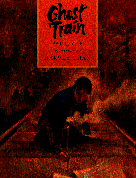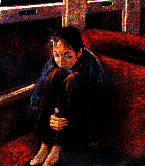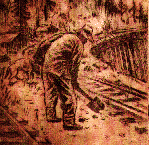


|
Ghost Train.
Paul Yee. Illustrated by Harvey Chan. Subject Headings:
Grades 3 - 7 / Ages 8 - 12. **** /4
|

excerpt:
Then one day a letter came enclosing a large sum of money."Choon-yi, my daughter, come quick!" her father's words said. "Bring your ink brushes and your colors. Bring a roll of the finest paper you can find!"
Choon-yi tied her belongings into a carrying sash and sailed on the next ship to North America. In the bustling port city, she hurried to the company office to ask where her father worked.
The paymaster checked his ledger and looked up grimly.
"I am sorry, child, but your father was killed last week," he said. "The side of the mountain collapsed and carried his crew into the river far below. No bodies were found."
He handed her a final pay packet and turned away.
 In Ghost Train, Yee returns to a theme he first treated in his collection,
Tales from Gold Mountain, which describes the experiences of the Chinese,
especially poor peasant farmers, who, in the nineteenth century, came to
North America, a continent
they perceived to be a land of riches. Like "Spirits of the Railway,"
Tales' opening story, Ghost Train deals with the "ghosts" of Chinese
workers who died while building the railway. The ghosts cannot rest until
their "bodies" are buried, even if that burial is only symbolic.
In Ghost Train, Yee returns to a theme he first treated in his collection,
Tales from Gold Mountain, which describes the experiences of the Chinese,
especially poor peasant farmers, who, in the nineteenth century, came to
North America, a continent
they perceived to be a land of riches. Like "Spirits of the Railway,"
Tales' opening story, Ghost Train deals with the "ghosts" of Chinese
workers who died while building the railway. The ghosts cannot rest until
their "bodies" are buried, even if that burial is only symbolic.

Choon-yi, born with one arm to poor peasants in South China,
possessed a remarkable talent for realistic painting. When she was twelve, her
beloved father emigrated to North America to become a railway worker, a
lucrative but dangerous occupation. Now, two years later, he sends her
money to emigrate and tells her to bring her art supplies. Upon Choon-yi's
arrival, she learns that her father and his crew have recently been killed
in a rock slide and "no bodies were found." The night before Choon-yi is
to return home, her father appears in a dream, saying, "Paint me the
train that runs on the road I built." With great difficulty and following
two more visits from her father, Choon-yi finally captures the train in her
painting and actually "rides" on it where, as she walks through the cars,
she recognizes that the passengers are really the souls of workers whose
"bones will never be recovered." When she next sees her painting, in each
window she now observes faces. Taking the painting back to China, she will
fulfil her father's final wish - to burn it on the highest hill so that the
ashes will "sail on the four winds" and "our souls will finally find their
way home."
Chan, who also illustrated Yee's Roses Sing on New Snow, demonstrates his versatility by switching from the bright watercolours he used in the
lighter, more humorous Roses to sombre oils which better match the much
darker mood of Ghost Train. Unlike the variety of sizes, shapes and
placements of illustrations found in Roses, Ghost Train principally
juxtaposes full-page paintings and text pages.
Though Ghost Train utilizes a picture book format, its contents are
for a mature audience.
Highly Recommended
Dave Jenkinson teaches children's and adolescent literature courses at the Faculty of Education, University of Manitoba.

To comment on this title or this review, send mail to cm@umanitoba.ca.
Copyright © 1996 the Manitoba Library Association. Reproduction for personal use is permitted only if this copyright notice is maintained. Any other reproduction is prohibited without permission.
Published by
The Manitoba Library Association
ISSN 1201-9364
AUTHORS |
TITLES |
MEDIA REVIEWS |
BOOKSHELF
BACK ISSUES |
SEARCH |
HOME